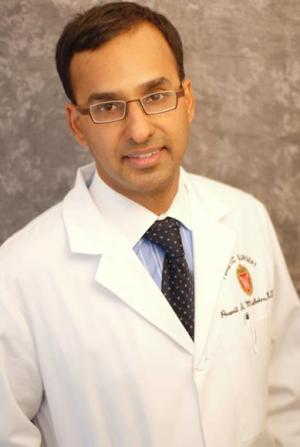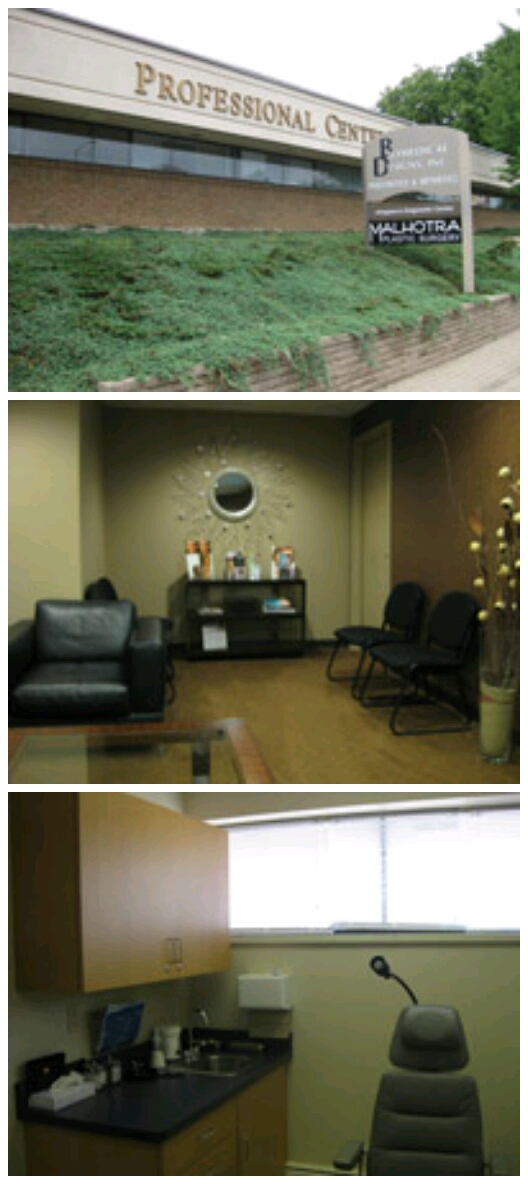Dr. Pramit S. Malhotra: The Malhotra Center For Plastic Surgery In Michigan
/ Pramit S. Malhotra MD is double board certified as a plastic surgeon and otolaryngologist with clinics in Ann Arbor and Jackson Michigan.
Pramit S. Malhotra MD is double board certified as a plastic surgeon and otolaryngologist with clinics in Ann Arbor and Jackson Michigan.
Dr. Malhotra was named a top plastic surgeon by the Consumer Research Council of America in 2009. We wanted to find out how this busy plastic surgeon manages two practices and what he thinks about the state of cosmetic medicine.
Name: Pramit S. Malhotra MD, MS
Location: Ann Arbor and Jackson, MI
Website: annarborplasticsurgery.com
That's interesting: Dr. Malhotra is an author of over a dozen publications for professional medical journals on topics including Botox, rhinoplasty, and head and neck cancers.
Where is your clinic located?
My practice is really a tale of two cities. My main office is a college town that frequently is cited as the most educated city in America. It would not be uncommon for my patients to have a typed list of questions a page long, broken down into several categories. I am very detail-oriented, so I see myself in many of my patients.
The other office is in a city that predominantly has a manufacturing base. My patients here tend to be more sensitive to price and time off from work. We have refined many of our surgeries to incorporate quick recovery techniques to minimize time away from work.
How do you manage and compensate your staff?
I firmly agree with the statement that “the most precious resource is human resources.”
We are staffed by an office manager, a patient care coordinator, a new nurse shortly, and a receptionist. All employees wear multiple hats and can cover different positions, however each person has a specific role, expertise, and duties.
Our staff travels from one office to the next, a distance of 35 miles. We assign a patient care coordinator to every surgical patient so that each patient has a specific person with whom they can interact. This allows for consistency in instructions and care and has been a key component of satisfaction for our patients. Often the patients will remember their patient coordinator’s name years later and not mine. Humbling indeed!
I have never talked with another plastic surgeon who has been pleased with every hire. We do not offer direct incentive programs, though we do give bonuses for outstanding performance. My experience is that superstars can’t help but perform. It is in their DNA! We try to find and nurture superstars by bonuses, flexibility, respect, continued education, and positive feedback.
What cosmetic technologies do you like? Which do you dislike and why?
We have a Sciton BBL machine that is off-site inside of a women’s health center owned by our local hospital. We have been very pleased with our Sciton BBL unit as a primary workhorse machine. It has really proven to be an ideal first entry purchase into higher level medical spa services.
In our main office, we have Zeltiq’s Coolsculpting technology. We have been quite pleased with this technology. Our hypothesis was that a non-invasive body contouring procedure would particularly appeal to the highly-educated, fitness-conscious population we serve. Coolsculpting has brought in a new category of patients who hadn’t considered cosmetic services before. We think this group will grow into a loyal patient base. We do select patients very carefully for this technology, resulting in satisfaction rates above 90%.

What technologies are you using and what 'sold' you on them? Was it price, function or something else?
We were an early adopter of Zeltiq’s Coolsculpting technology in early 2011 after its FDA approval in September 2010. We had heard from colleagues who were testing this device that it was reliable and efficacious. This peaked our interest. When a clinic nearby went from two machines to six machines in a matter of months, we were convinced of its demand. Our ROI for this technology was 11 months. This has not been a big profit center for us overall. We find that it attracts patients to our services that wouldn’t otherwise consider talking with a plastic surgeon. About 15% of patients end up not being candidates and half of those choose surgical alternatives instead.
How do you keep up with trends on technology? Have you seen anything impressive or interesting?
The non-invasive body contouring technologies continue to be very interesting.
Liposonix for fat reduction seems to be promising. We did use the lipodissolve technique for fat reduction by injection. We found the results to be marginal. Kythera Biopharmaceuticals is manufacturing a compound ATX-101, a bile acid, which is a variant of the Lipodissolve science. This may prove efficacious for chin lipodystrophy.
Do you think that cosmetic surgery will evolve? Will it be changed by technology?
Plastic surgery changes dramatically every year due to technology. These changes are patient focused to fit patients that want smaller changes, less down time, and less risk. This is a mega trend in cosmetic surgery that will continue to grow as non-invasive procedures efficacy continues to grow. We are seeing a younger demographic of patients seeking non-surgical technologies. Many adults who grew up in the 1980’s feel very comfortable with small non-invasive procedures incorporated into their health and beauty maintenance routines.
How do you market your clinic?
We have see marketing strategies change quickly every year. In one community where we have served over 3000 patients, our referral sources are mainly word of mouth and the internet. Marketing via local newspapers in this community was once very effective; however less so now. The majority of our patients now “shop” our practice by internet searches and research using online reviews. We follow up with all our patients to make sure our services met their expectations. This has been critical to building a patient base that tells their friends and spreads the word for us. We emphasize quality over quantity, and if we feel our service level falls due to volume overload, we make adjustments in our staffing, scheduling, and practice mix.
We have found search engine marketing and search engine optimization to be very important. In fact, the results have surprised us. Many colleagues have noted 60 to 70% of their patients find them through the Internet.

Where do you spend your marketing dollars? Have you had anything that's worked extremely well?
We focus our marketing budget on providing prospective patients with an outstanding website that has customized content that is educational. We believe a better informed patient will choose our practice over others. We spend about 6% of gross revenues on marketing. We spend about 60% of our budget on a mixture of search engine marketing, pay-per- click, web site upgrades, and directory listings. We continue to use some print advertising in local newspapers and monthlies to maintain general community awareness.
What is the best advice that you ever got as a plastic surgeon?
Underpromise and overdeliver.
What treatment modalities create the most sales for you?
As a primarily surgical focused practice, 75% of our revenues are from surgery, 20% from injectables, and 5% from Coolsculpting.
We have struggled with the profitability of injectable services as these have become more commoditized. In our clinic, patients seeking injectable services talk with a nurse or patient care coordinator first who suggests a treatment plan, applies topical lidocaine cream, and goes over pricing. About 70% of patients are triaged this way. This allows me to confirm the treatment plan and inject with a single encounter in the room. Patients who are new or who would like to talk with the physician first are the remaining 30%. This has increased my efficiency and allowed us to be price competitive in our community.
Any funny stories?
Of course. My office manager was very committed to a dog rescue program. She had decided that what my wife and I needed was a puppy to complement our new home. It seemed like every week, she would bring up a new dog to consider. One afternoon, she called me out to our lobby to show me a basket full of golden retriever puppies. The puppies escaped from the basket and began bounding about the room, eventually running into the glass doors in an effort to get outside. It was complete mayhem and memorably adorable.
What insights or advice would you give to other physicians that could benefit them?
I would recommend that you assess your community well. You should know what services are being offered, what services are being performed poorly, and what businesses are run well. You can send friends and family to check out other practices, gain information through mystery shopping services, and search online reviews and forums. Even in very competitive markets, there is always room for one more practioner who has complete focus on patient satisfaction.
About: Dr. Malhotra graduated from the University of Michigan Honors College cum laude. After completing medical school at the Ohio State College of Medicine, Dr. Malhotra trained in Head and Neck Surgery with a focus on facial plastic surgery at the University of Minnesota. He was awarded a 6 month research fellowship at the National Institutes of Health, one of the world's leading institutes for medical research. Dr. Malhotra earned a Master of Science degree for his cancer research in addition to his medical doctorate. Additional training was completed as the chief plastic surgery fellow at University of Wisconsin.
My initial exposure to plastic surgery was through reconstructive surgery for patients with head and neck cancer. I often tell patients that I have both removed and reconstructed every part of the face.
This interview is part of a series of interviews of physicians running medical spas, laser clinics and cosmetic surgery centers. If you'd like to be interviewed, just contact us.





